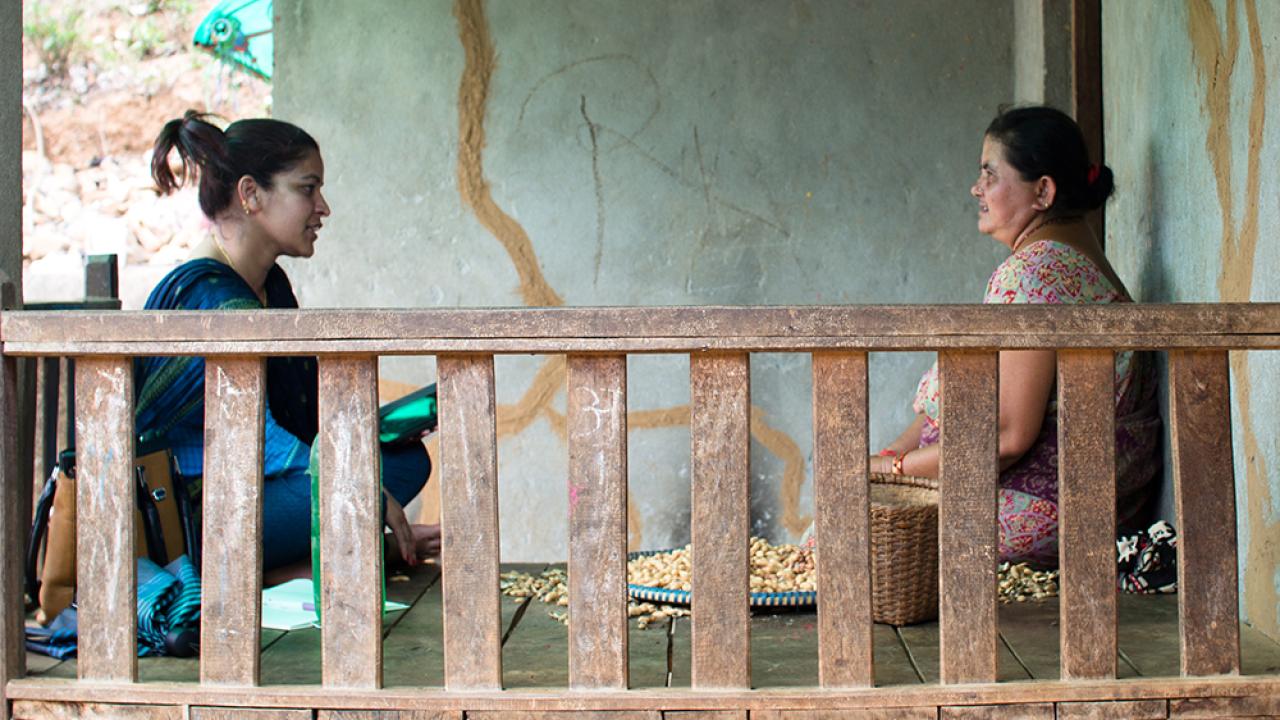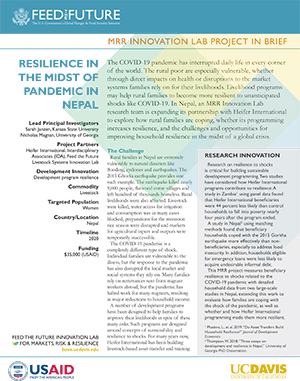
The COVID-19 pandemic has interrupted daily life in every corner of the world. The rural poor are especially vulnerable, whether through direct impacts on health or disruptions to the market systems families rely on for their livelihoods. Livelihood programs may help rural families to become more resilient to unanticipated shocks like COVID-19.
In Nepal, an MRR Innovation Lab research team is expanding its partnership with Heifer International to explore how rural families are coping, whether its programming increases resilience, and the challenges and opportunities for improving household resilience in the midst of a global crisis.
Project overview
Lead Principal Investigators: Sarah Janzen, University of Illinois
Nicholas Magnan, University of Georgia
Sudhindra Sharma, IDA
Project Partners: Heifer International, Interdisciplinary Associates (IDA), Feed the Future Livestock Systems Innovation Lab
Development Innovation: Development program resilience
Commodity: Livestock
Targeted Population: Women
Country/Location: Nepal
Timeline: 2020
Funding: $35,000 (USAID)
The Challenge
Rural families in Nepal are extremely vulnerable to natural disasters like flooding, cyclones and earthquakes. The 2015 Ghorka earthquake provides one such example. The earthquake killed nearly 9,000 people, flattened entire villages and left hundred of thousands homeless. Rural livelihoods were also affected. Livestock were killed, water access for irrigation and consumption was in many cases blocked, preparations for the monsoon rice season were disrupted and markets for agricultural inputs and outputs were temporarily inaccessible.
The COVID-19 pandemic is a completely different type of shock. Individual families are vulnerable to the illness, but the response to the pandemic has also disrupted the local market and social systems they rely on. Many families rely on remittances sent from migrant workers abroad, but the pandemic has halted work for many migrants, resulting in major reductions to household income.
A number of development programs have been designed to help families to improve their livelihoods in spite of these many risks. Such programs are designed around concepts of sustainability and resilience to shocks. For many years now, Heifer International has been building livestock-based asset transfer and training programs in Nepal to facilitate building a sustainable and independent income.
While there is no precedent for an unanticipated shock like COVID-19, programs like Heifer International’s in Nepal provide an opportunity to learn more about how families are coping with hardship related to the COVID-19 pandemic.
Researchers can take advantage of this baseline data, combined with new phone-based survey data, to analyze household resiliency and program impacts in the midst of crisis. In recent years, USAID supported two research projects in collaboration with Heifer International in Nepal. The first was a rigorous randomized evaluation of a Heifer International rural livelihoods program through the Feed the Future Innovation Lab for Assets and Market Access. The second was an evaluation of a novel digital technology to improve goat-selling cooperative performance, supported by the Feed the Future Livestock Systems Innovation Lab. Both projects collected extensive household survey data.

Research Design
An MRR Innovation Lab research team is building on its six-year partnership encompassing both of these projects for the most rigorous study to date of Heifer International programming focused on resilience. First, the study is conducting a rapid assessment examining the ways in which rural households have been affected by the COVID-19 pandemic using phone surveys with 75 community self-help group members and 25 cooperative leaders. Both are groups established through Heifer International programming.
Second, researchers are leveraging the Feed the Future Innovation Lab for Assets and Market Access evaluation where the original treatment statuses of study households is still intact. The program formed women’s self-help groups, encouraged savings, provided a livestock transfer and offered extensive training on improved livestock management practices, entrepreneurship and values. The main panel dataset collected for the original study has a sample size of more than 1,700 beneficiaries. Baseline data was collected in 2014, with follow-up data collected in 2016, 2017 and 2018. This evaluation included an analysis of how families coped with the 2015 Gorkha earthquake that struck a number of the communities in which the research was actively taking place. The MRR Innovation Lab research team is leveraging the original experimental design, extensive baseline data and a database of respondent phone numbers.
Based on the results of the rapid assessment and building on experiences evaluating resilience to the devastating 2015 Ghorka earthquake, the MRR research team is creating a phone survey that will extend the evaluation of Heifer International programming and its impact on resilience in the midst of the COVID-19 pandemic.
Development Impact
The findings from this project will help inform Heifer International’s disaster response efforts in Nepal and elsewhere. The organization is uniquely positioned to layer a response on top of existing social and market infrastructure.
This project may also lead to new financial or market innovations to be implemented by Heifer International. Cooperatives established by the organization could offer loans or grants to beneficiaries, for example. These innovations could also lead to new research opportunities to evaluate their effectiveness and impact by leveraging data collected in either of the studies previously supported by USAID and Feed the Future, as well as other ongoing studies of Heifer International programs in Nepal.
This report is made possible by the generous support of the American people through the United States Agency for International Development (USAID) cooperative agreement 7200AA19LE00004. The contents are the responsibility of the Feed the Future Innovation Lab for Markets, Risk and Resilience and do not necessarily reflect the views of USAID or the United States Government.
